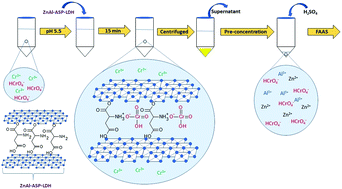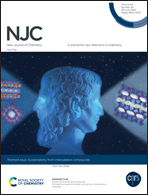A dispersive solid phase extraction-based method for chromium(vi) analysis using a Zn–Al layered double hydroxide intercalated with l-aspartic acid as a dissolvable adsorbent
Abstract
The development of safe analytical methodologies for the determination of Cr(VI) in the environment is urgent due to the risks that this element can cause to living beings due to its high toxicity. In this work, a method was developed for the determination of Cr(VI) in water samples by flame atomic absorption spectrometry (FAAS). The method was based on dispersive solid phase extraction (DSPE) as a route for Cr(VI) speciation and preconcentration. A zinc–aluminum layered double hydroxide intercalated with the amino acid L-aspartic acid (ZnAl-ASP-LDH) was used as an adsorbent for DSPE. ZnAl-ASP-LDH has unique properties and can be used in DSPE for Cr(VI) determination and, at the end of the process, it can be easily dissolved in acid medium, making extraction highly efficient. The parameters that influence the selective adsorption of Cr(VI) by ZnAl-ASP-LDH in aqueous solutions, such as, for example, the initial pH value, the contact time and interfering ions, were studied and optimized. In solutions containing the concomitant presence of Cr(VI) and Cr(III) species, the best selective extraction of Cr(VI) was obtained at pH 5.5, with maximum extraction after 10 min. The presence of interfering ions, such as F−, Cl−, NO3−, SO42−, Na+, K+, Mg2+ or Zn2+, showed no significant effect on the Cr(VI) extraction by ZnAl-ASP-LDH from the solution. After extraction of Cr(VI), the ZnAl-ASP-LDH adsorbent phase was dissolved in H2SO4 5 mol L−1 and analyzed by FAAS. The use of eluents was eliminated, which allowed the increase of sensitivity besides no matrix effect. The method presented a linear range of 10–700 μg L−1 and correlation coefficient of r2 = 0.999, in which the limits of detection (LOD) and quantification (LOQ) were 3.13 μg L−1 and 10.43 μg L−1, respectively. The relative standard deviation (RSD) was 2.95% (n = 10). The reliability of the method was verified using certified water containing Cr(VI) (Cr(VI)-QC1453) and by recovery studies using drinking water samples.

- This article is part of the themed collection: Sustainability from intercalation compounds


 Please wait while we load your content...
Please wait while we load your content...